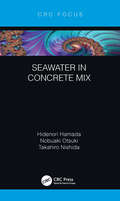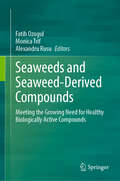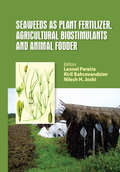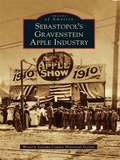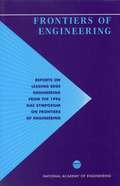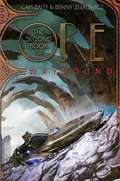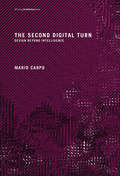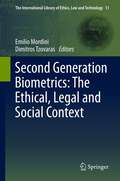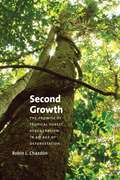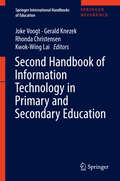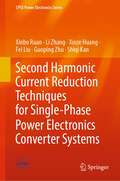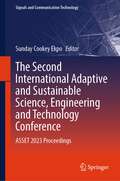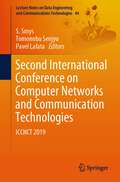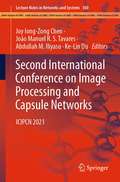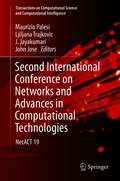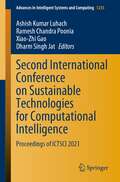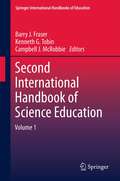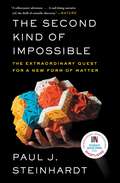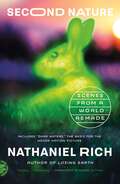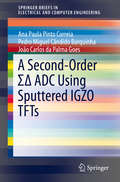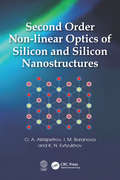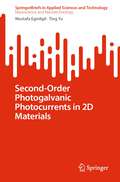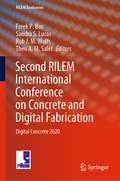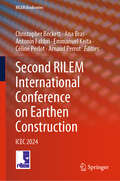- Table View
- List View
Seawater in Concrete Mix
by Hidenori Hamada Nobuaki Otsuki Takahiro NishidaIn the near future, many parts of the world will suffer from a shortage of freshwater. Effective use of seawater in concrete production could therefore become a crucial technology. Seawater in Concrete Mix provides a detailed overview of the fundamental knowledge of concrete engineering that is essential for the usage of seawater-mixed concrete. According to the worldwide standard for reinforced concrete (RC), freshwater is typically used in concrete mixing rather than seawater. Yet a potential exists for the extensive use of seawater in concrete, especially with the addition of ground granulated blast-furnace slag, fly ash, or other mineral admixtures. The recent trend toward performance-based design makes this alternative more viable. The text is ideal for graduate students, researchers, concrete engineers, and all civil engineers who deal with concrete for infrastructure. Hidenori Hamada is Professor of Kyushu University, Japan. Nobuaki Otsuki is Professor Emeritus of Tokyo Institute of Technology and was Chairman of the JCI Technical Committee on the use of seawater in concrete. Takahiro Nishida is Senior Researcher of the Japanese National Institute of Maritime, Port and Aviation Technology.
Seaweeds and Seaweed-Derived Compounds: Meeting the Growing Need for Healthy Biologically Active Compounds
by Fatih Ozogul Monica Trif Alexandru RusuRecent advances in the industrial application and industrial development of seaweeds are important in addressing the world's growing needs for healthy nutrients. Seaweeds are a potentially sustainable feedstock for future food and feed, green chemicals, and fuels. For seaweed biorefinery, the fractionation of the biomass to co-produce multiple products is crucial in the efficient valorization of the aquatic biomass. Widespread use of seaweed is still limited by a number of factors including harvesting access, seasonality and geographical location of algae, toxicological aspects, as well as the availability of scalable production methods. A good example is protein isolation from algae, since current processes of algal protein isolation are time-consuming and economically unviable. Seaweeds and Seaweed-Derived Compounds offers a comprehensive overview of sustainable seaweeds for the recovery of low-cost dietary nutrients from algae and alga-based biomass and their validation to meet market the requirements of consumers and industry in different sectors. With chapters focusing on seaweeds as foods, pharmaceuticals and cosmetic and dermatological applications, this text provides multidisciplinary knowledge of this sustainable biomass presented with a mix of academic and industrial perspectives.
Seaweeds as Plant Fertilizer, Agricultural Biostimulants and Animal Fodder
by Leonel Pereira Kiril Bahcevandziev Nilesh H. JoshiThe main effects of Seaweed extracts (Ascophyllum, Fucus, Sargassum, Saccorhiza, Laminaria, Gelidium and others), when used as agricultural fertilizers, are better seed germination and higher quality fruit production, with longer shelf life; better use of soil nutrients; more productive crops and plants with greater resistance to unfavorable environmental conditions. Algae also have a long history of use as animal feed. They have a highly variable composition depending on the species, collection season and habitat, and on external conditions such as water temperature, light intensity and nutrient concentration in water. In relation to ruminal fermentation, a high variability of the digestibility values was found among seaweed species and cannot be attributed only to the composition of different nutrients of the algae. The role of marine algae for reduction of methane production is discussed with particular emphasis on novel algae-based feed strategies that target minimal methane emissions without affecting the functionality of the microbiota and overall animal productivity. Key Features: Sustainable Agriculture Natural Feeding Nutrients Liquid Seaweed Agricultural Biostimulants Natural Pesticides
Sebastopol's Gravenstein Apple Industry
by Western Sonoma County Historical SocietyThe Gravenstein apple has been etched into the identity of Sebastopol, California, which is one of the few places on earth to have extensively grown this elusive apple. The Gravenstein is an early apple whose only failing is perishability, but it is celebrated for its superior flavor. Yet Luther Burbank attempted to improve on the Gravenstein, producing the Winterstein and the Bonita for home gardeners. During the last 127 years, the Gravenstein has added millions of dollars to the local economy. It has provided a reason for celebrations, from the 1910 Apple Show to today's Apple Blossom Festival and Gravenstein Apple Fair. This is the Gravenstein's story, from its European roots to small-town homage, and the part this special apple has played in one community--and the reason the current decline in apple acreage is mourned.
Second Annual Symposium on Frontiers of Engineering
by National Academy of Engineering Staff Second Annual Symposium on Frontiers of Engineering StaffSpace may have been called the "final frontier," but there are new frontiers to discover every day and engineers are the ones exploring them. Through groundbreaking research and cutting-edge technologies, engineers are now able to go beyond traditional boundaries, doing things that would have been all but impossible just a few short years ago. A sample of these exciting frontiers is revealed in this new publication from the National Academy of Engineering, which looks at new and emerging technologies to explain how they were developed and what new benefits they will bring. The book also highlights the kinds of pioneering research and technological work being done by some of the country's emerging leaders in engineering. Topics covered include microelectromechanical systems, design research, computer-generated visualization for design and display, and innovations in materials and processes.
The Second Book of Ore: Waybound (The Books of Ore #2)
by Benny Zelkowicz Cam BaityPhoebe Plumm and Micah Tanner are a long way from home and entrenched in a struggle with no end in sight. The Foundry, an all-powerful company that profits off the living metal creatures of Mehk, is unleashing a wave of devastating attacks to crush the rebel army of mehkans known as the Covenant and capture Phoebe and Micah, dead or alive. But the Covenant believes that their ancient god, Makina, has chosen Phoebe for a sacred task: to seek the Occulyth, a mysterious object they hope can turn the tide against the Foundry. With her father gone, Phoebe's once unshakable determination is broken, and while Micah tries to uphold the vow he made to protect her no matter the cost, their enemies are closing in and time is running out.
The Second Day at Gettysburg
by Gary GallagherDifferent historians examine commanders who fought at Gettysburg.
The Second Digital Turn: Design Beyond Intelligence (Writing Architecture)
by Mario CarpoThe first digital turn in architecture changed our ways of making; the second changes our ways of thinking.Almost a generation ago, the early software for computer aided design and manufacturing (CAD/CAM) spawned a style of smooth and curving lines and surfaces that gave visible form to the first digital age, and left an indelible mark on contemporary architecture. But today's digitally intelligent architecture no longer looks that way. In The Second Digital Turn, Mario Carpo explains that this is because the design professions are now coming to terms with a new kind of digital tools they have adopted—no longer tools for making but tools for thinking. In the early 1990s the design professions were the first to intuit and interpret the new technical logic of the digital age: digital mass-customization (the use of digital tools to mass-produce variations at no extra cost) has already changed the way we produce and consume almost everything, and the same technology applied to commerce at large is now heralding a new society without scale—a flat marginal cost society where bigger markets will not make anything cheaper. But today, the unprecedented power of computation also favors a new kind of science where prediction can be based on sheer information retrieval, and form finding by simulation and optimization can replace deduction from mathematical formulas. Designers have been toying with machine thinking and machine learning for some time, and the apparently unfathomable complexity of the physical shapes they are now creating already expresses a new form of artificial intelligence, outside the tradition of modern science and alien to the organic logic of our mind.
Second Generation Biometrics: The Ethical, Legal and Social Context
by Dimitros Tzovaras Emilio MordiniWhile a sharp debate is emerging about whether conventional biometric technology offers society any significant advantages over other forms of identification, and whether it constitutes a threat to privacy, technology is rapidly progressing. Politicians and the public are still discussing fingerprinting and iris scan, while scientists and engineers are already testing futuristic solutions. Second generation biometrics - which include multimodal biometrics, behavioural biometrics, dynamic face recognition, EEG and ECG biometrics, remote iris recognition, and other, still more astonishing, applications - is a reality which promises to overturn any current ethical standard about human identification. Robots which recognise their masters, CCTV which detects intentions, voice responders which analyse emotions: these are only a few applications in progress to be developed. This book is the first ever published on ethical, social and privacy implications of second generation biometrics. Authors include both distinguished scientists in the biometric field and prominent ethical, privacy and social scholars. This makes this book an invaluable tool for policy makers, technologists, social scientists, privacy authorities involved in biometric policy setting. Moreover it is a precious instrument to update scholars from different disciplines who are interested in biometrics and its wider social, ethical and political implications.
Second Growth: The Promise of Tropical Forest Regeneration in an Age of Deforestation
by Robin L. ChazdonFor decades, conservation and research initiatives in tropical forests have focused almost exclusively on old-growth forests because scientists believed that these "pristine” ecosystems housed superior levels of biodiversity. With Second Growth, Robin L. Chazdon reveals those assumptions to be largely false, bringing to the fore the previously overlooked counterpart to old-growth forest: second growth. Even as human activities result in extensive fragmentation and deforestation, tropical forests demonstrate a great capacity for natural and human-aided regeneration. Although these damaged landscapes can take centuries to regain the characteristics of old growth, Chazdon shows here that regenerating--or second-growth--forests are vital, dynamic reservoirs of biodiversity and environmental services. What is more, they always have been. With chapters on the roles these forests play in carbon and nutrient cycling, sustaining biodiversity, providing timber and non-timber products, and integrated agriculture, Second Growth not only offers a thorough and wide-ranging overview of successional and restoration pathways, but also underscores the need to conserve, and further study, regenerating tropical forests in an attempt to inspire a new age of local and global stewardship.
Second Handbook of Information Technology in Primary and Secondary Education
by Joke Voogt Gerald Knezek Rhonda Christensen Kwok-Wing LaiIn this second edition the editors continue their efforts to synthesize research and practice and project future directions in the field of information and communication technology. The proliferation of mobile devices and applications have had major implications on how the nature of teaching and learning should be conceptualised, and what pedagogical practices should be used to support bridging formal and informal learning. The advent of social media also highlights the importance of gaining a deeper understanding of social learning theories and computer-supported collaborative learning theories and practices. The advancement of new technologies to support easy accessibility of educational resources such as OER and to a lesser extent MOOCs have led to the debate on how assessment should be conducted and how technologies could be used to support it. The demand of the knowledge society requires that researchers, policy makers, and educational practitioners be conversant with new research findings in order to understand the impact of ICT in teaching and learning, and how to support learners to use new technologies and applications creatively and effectively. New research paradigms have emerged to meet these challenges.
Second Harmonic Current Reduction Techniques for Single-Phase Power Electronics Converter Systems (CPSS Power Electronics Series)
by Xinbo Ruan Li Zhang Xinze Huang Fei Liu Guoping Zhu Shiqi KanTwo-stage single-phase converters, including two-stage single-phase dc-ac inverters and two-stage single-phase PFC converters, are interfacing power converters between dc and ac voltage/current sources, which have been widely applied for dc-ac and ac-dc power conversion. For the two-stage single-phase converter, the ac-side power pulsates at twice the ac voltage frequency, resulting in second harmonic current (SHC) which might flow into the dc-dc converter, the dc voltage source, and dc load. This book clarifies the generation, propagation, and side-effects of this SHC and proposes the SHC reduction control schemes for the dc-dc converter, with different topologies and/or different operating modes, in the single-phase converter. On this basis, the second harmonic current compensator (SHCC) is proposed to compensate the SHC, significantly reducing the dc bus capacitance. In doing so, the electrolytic capacitors, with short lifetimes, are removed from the two-stage single-phase converter, leading to extended system lifetime and enhanced system stability. For having flawless SHC compensation performance, the port-current control schemes are proposed for the SHCC. Additionally, the stability analysis is carried out for the two-stage single-phase converter with the addition of SHCC. This book is a monograph combining theoretical analysis and engineering design, which could not only be a reference book for master students, Ph.D. students, and teachers majoring in power electronics but also be a handbook for the electrical engineers working on the research and development of LED drivers, EV on-board chargers, railway auxiliary power supplies, aviation power supplies, renewable energy generation systems, etc.
The Second International Adaptive and Sustainable Science, Engineering and Technology Conference: ASSET 2023 Proceedings (Signals and Communication Technology)
by Sunday Cookey EkpoThis proceedings presents papers from the Second International Adaptive and Sustainable Science, Engineering and Technology Conference (ASSET 2023), which took place simultaneously in Manchester, UK and Ikot Akpaden, Nigeria on 18-20, July 2023. The ASSET conference serves as an interactive forum for the advancement of the practice of adaptive and sustainable systems across the multiple disciplines and specialty areas involved with the science, engineering, and technology of integrated entities, complex systems, and networks. The conference provides an avenue for practitioners, researchers, managers, developers, analysts, educators, and users to exchange innovative ideas, concepts, applications, and lessons learned in addressing domain-specific problems, applications-oriented topics, methodologies, standards and multidisciplinary research opportunities and findings relating to ASSET systems.
Second International Conference on Computer Networks and Communication Technologies: ICCNCT 2019 (Lecture Notes on Data Engineering and Communications Technologies #44)
by S. Smys Tomonobu Senjyu Pavel LafataThis book presents new communication and networking technologies, an area that has gained significant research attention from both academia and industry in recent years. It also discusses the development of more intelligent and efficient communication technologies, which are an essential part of current day-to-day life, and reports on recent innovations in technologies, architectures, and standards relating to these technologies. The book includes research that spans a wide range of communication and networking technologies, including wireless sensor networks, big data, Internet of Things, optical and telecommunication networks, artificial intelligence, cryptography, next-generation networks, cloud computing, and natural language processing. Moreover, it focuses on novel solutions in the context of communication and networking challenges, such as optimization algorithms, network interoperability, scalable network clustering, multicasting and fault-tolerant techniques, network authentication mechanisms, and predictive analytics.
Second International Conference on Image Processing and Capsule Networks: ICIPCN 2021 (Lecture Notes in Networks and Systems #300)
by Joy Iong-Zong Chen João Manuel R. S. Tavares Abdullah M. Iliyasu Ke-Lin DuThis book includes the papers presented in 2nd International Conference on Image Processing and Capsule Networks [ICIPCN 2021]. In this digital era, image processing plays a significant role in wide range of real-time applications like sensing, automation, health care, industries etc. Today, with many technological advances, many state-of-the-art techniques are integrated with image processing domain to enhance its adaptiveness, reliability, accuracy and efficiency. With the advent of intelligent technologies like machine learning especially deep learning, the imaging system can make decisions more and more accurately. Moreover, the application of deep learning will also help to identify the hidden information in volumetric images. Nevertheless, capsule network, a type of deep neural network, is revolutionizing the image processing domain; it is still in a research and development phase. In this perspective, this book includes the state-of-the-art research works that integrate intelligent techniques with image processing models, and also, it reports the recent advancements in image processing techniques. Also, this book includes the novel tools and techniques for deploying real-time image processing applications.The chapters will briefly discuss about the intelligent image processing technologies, which leverage an authoritative and detailed representation by delivering an enhanced image and video recognition and adaptive processing mechanisms, which may clearly define the image and the family of image processing techniques and applications that are closely related to the humanistic way of thinking.
Second International Conference on Networks and Advances in Computational Technologies: NetACT 19 (Transactions on Computational Science and Computational Intelligence)
by Maurizio Palesi Ljiljana Trajkovic J. Jayakumari John JoseThis book presents the proceedings of the 2nd International Conference on Networks and Advances in Computational Technologies (NetACT19) which took place on July 23-25, 2019 at Mar Baselios College of Engineering and Technology in Thiruvananthapuram, India. The conference was in association with Bowie State University, USA, Gannon University, USA and Malardalen University, Sweden. Papers presented were included in technical programs that were part of five parallel tracks, namely Computer Application, Image Processing, Network Security, Hardware & Network Systems and Machine Learning. The proceedings brings together experts from industry, governments and academia from around the world with vast experiences in design, engineering and research.Presents the proceedings of the 2nd International Conference on Networks and Advances in Computational Technologies (NetACT19);Includes research in Computer Application, Image Processing, Network Security, Hardware & Network Systems and Machine Learning;Provides perspectives from industry, academia and government.
Second International Conference on Sustainable Technologies for Computational Intelligence: Proceedings of ICTSCI 2021 (Advances in Intelligent Systems and Computing #1235)
by Ashish Kumar Luhach Ramesh Chandra Poonia Xiao-Zhi Gao Dharm Singh JatThis book gathers high-quality papers presented at the Second International Conference on Sustainable Technologies for Computational Intelligence (ICTSCI 2021) held at Graphic Era University, Dehradun, India, during May 22–23, 2021. It covers emerging topics in computational intelligence and effective strategies for its implementation in engineering applications.
Second International Handbook of Science Education
by Campbell J. Mcrobbie Barry J. Fraser Kenneth TobinThe International Handbook of Science Education is a two volume edition pertaining to the most significant issues in science education. It is a follow-up to the first Handbook, published in 1998, which is seen as the most authoritative resource ever produced in science education. The chapters in this edition are reviews of research in science education and retain the strong international flavor of the project. It covers the diverse theories and methods that have been a foundation for science education and continue to characterize this field. Each section contains a lead chapter that provides an overview and synthesis of the field and related chapters that provide a narrower focus on research and current thinking on the key issues in that field. Leading researchers from around the world have participated as authors and consultants to produce a resource that is comprehensive, detailed and up to date. The chapters provide the most recent and advanced thinking in science education making the Handbook again the most authoritative resource in science education.
The Second Kind of Impossible: The Extraordinary Quest for a New Form of Matter
by Paul SteinhardtOne of the most fascinating scientific detective stories of the last fifty years, an exciting quest for a new form of matter. The Second Kind of Impossible reads like James Gleick’s Chaos combined with an Indiana Jones adventure.When leading Princeton physicist Paul Steinhardt began working in the 1980s, scientists thought they knew all the conceivable forms of matter. The Second Kind of Impossible is the story of Steinhardt’s thirty-five-year-long quest to challenge conventional wisdom. It begins with a curious geometric pattern that inspires two theoretical physicists to propose a radically new type of matter—one that raises the possibility of new materials with never before seen properties, but that violates laws set in stone for centuries. Steinhardt dubs this new form of matter “quasicrystal.” The rest of the scientific community calls it simply impossible. The Second Kind of Impossible captures Steinhardt’s scientific odyssey as it unfolds over decades, first to prove viability, and then to pursue his wildest conjecture—that nature made quasicrystals long before humans discovered them. Along the way, his team encounters clandestine collectors, corrupt scientists, secret diaries, international smugglers, and KGB agents. Their quest culminates in a daring expedition to a distant corner of the Earth, in pursuit of tiny fragments of a meteorite forged at the birth of the solar system. Steinhardt’s discoveries chart a new direction in science. They not only change our ideas about patterns and matter, but also reveal new truths about the processes that shaped our solar system. The underlying science is important, simple, and beautiful—and Steinhardt’s firsthand account is an engaging scientific thriller.
Second Nature: Scenes from a World Remade
by Nathaniel RichFrom the author of Losing Earth, a beautifully told exploration of our post-natural world that points the way to a new mode of ecological writing.We live at a time in which scientists race to reanimate extinct beasts, our most essential ecosystems require monumental engineering projects to survive, chicken breasts grow in test tubes, and multinational corporations conspire to poison the blood of every living creature. No rock, leaf, or cubic foot of air on Earth has escaped humanity's clumsy signature. The old distinctions—between natural and artificial, dystopia and utopia, science fiction and science fact—have blurred, losing all meaning. We inhabit an uncanny landscape of our own creation. In Second Nature, ordinary people make desperate efforts to preserve their humanity in a world that seems increasingly alien. Their stories—obsessive, intimate, and deeply reported—point the way to a new kind of environmental literature, in which dramatic narrative helps us to understand our place in a reality that resembles nothing human beings have known.From Odds Against Tomorrow to Losing Earth to the film Dark Waters (adapted from the first chapter of this book), Nathaniel Rich’s stories have come to define the way we think of contemporary ecological narrative. In Second Nature, he asks what it means to live in an era of terrible responsibility. The question is no longer, How do we return to the world that we’ve lost?It is, What world do we want to create in its place?
A Second-Order ΣΔ ADC Using Sputtered IGZO TFTs (SpringerBriefs in Electrical and Computer Engineering)
by Ana Paula Pinto Correia Pedro Miguel Cândido Barquinha João Carlos da Palma GoesThis books discusses the design, electrical simulation and layout of a 2nd-order ∑ analog-to-digital converter (ADC), using oxide thin-film transistors (TFTs) technology. The authors provide a unified view of materials science and electronics engineering, in order to guide readers from both fields through key topics. To accomplish this goal, background regarding materials, device physics, characterization techniques, circuit design and layout is given together with a detailed discussion of experimental data. The final simulation results clearly demonstrate the potential of the proposed circuit-level techniques, which enables the implementation of robust and energy efficient ADCs based on oxide TFTs, for moderate resolutions and conversion-rates.
Second Order Non-linear Optics of Silicon and Silicon Nanostructures
by O. A. Aktsipetrov I. M. Baranova K. N. EvtyukhovThe theory and practice of the non-linear optics of silicon are inextricably linked with a variety of areas of solid state physics, particularly semiconductor physics. However, the current literature linking these fields is scattered across various sources and is lacking in depth. Second Order Non-linear Optics of Silicon and Silicon Nanostructures describes the physical properties of silicon as they apply to non-linear optics while also covering details of the physics of semiconductors. The book contains six chapters that focus on: The physical properties and linear optics of silicon Basic theoretical concepts of reflected second harmonics (RSH) The authors’ theory of the generation of RSH at the non-linear medium–linear medium interface An analytical review of work on the non-linear optics of silicon The results of non-linear optical studies of silicon nanostructures A theory of photoinduced electronic processes in semiconductors and their influence on RSH generation The book also includes methodological problems and a significant amount of reference data. It not only reflects the current state of research but also provides a single, thorough source of introductory information for those who are becoming familiar with non-linear optics. Second Order Non-linear Optics of Silicon and Silicon Nanostructures is a valuable contribution to the fields of non-linear optics, semiconductor physics, and microelectronics, as well as a useful resource for a wide range of readers, from undergraduates to researchers.
Second-Order Photogalvanic Photocurrents in 2D Materials (SpringerBriefs in Applied Sciences and Technology)
by Mustafa Eginligil Ting YuThis book highlights the photogalvanic effects at low dimensions, surfaces, and interfaces, more specifically 2D materials, such as graphene and monolayer transition metal dichalcogenides. Although the phenomenology of the photogalvanic effects, which can be simply seen as photoresponse nonlinear-in-electric field, have been well-established, the microscopic understanding in each material system may vary. This book is a quick reference and a detailed roadmap starting from phenomenology and continuing with the ultimate low dimensional materials, in which the photogalvanic effects can offer a rich platform at the second-order response to an electric field. A general phenomenology of photogalvanic effect is provided in the first chapter, together with the photon drag effect which also generates a photocurrent like the photogalvanic effect, but with some distinct features, as well as somewhat puzzling similarities. Next two chapters explain these effects in graphene, starting with a necessary related background on graphene, then a particular focus on its specific phenomenology, microscopic theory, and experimental results. In a similar fashion, in chapters four and five, a necessary background for the photogalvanic effects in monolayer transition metal dichalcogenides, with symmetry analysis, microscopic theory, and experimental results is presented, along with the Berry curvature dependent photocurrent, which can also play an important role in 2D semiconductors. The second-order photogalvanic effects that have been covered so far in graphene and monolayer transition metal chalcogenides have already excited the 2D semiconductor optoelectronic research community by several means. It seems that the interests on the photogalvanic effects will continue to escalate in near future.
Second RILEM International Conference on Concrete and Digital Fabrication: Digital Concrete 2020 (RILEM Bookseries #28)
by Freek P. Bos Sandra S. Lucas Rob J. M. Wolfs Theo A. M. SaletThis book gathers peer-reviewed contributions presented at the 2nd RILEM International Conference on Concrete and Digital Fabrication (Digital Concrete), held online and hosted by the Eindhoven University of Technology, the Netherlands from 6-9 July 2020. Focusing on additive and automated manufacturing technologies for the fabrication of cementitious construction materials, such as 3D concrete printing, powder bed printing, and shotcrete 3D printing, the papers highlight the latest findings in this fast-growing field, addressing topics like mixture design, admixtures, rheology and fresh-state behavior, alternative materials, microstructure, cold joints & interfaces, mechanical performance, reinforcement, structural engineering, durability and sustainability, automation and industrialization.
Second RILEM International Conference on Earthen Construction: ICEC 2024 (RILEM Bookseries #52)
by Arnaud Perrot Christopher Beckett Antonin Fabbri Ana Bras Emmanuel Keita Céline PerlotThis book gathers the peer-reviewed papers presented at the Second RILEM International Conference on Earthen Construction (ICEC), held in Edinburgh, United Kingdom, on July 8–10, 2024. It highlights the latest advances and innovations in the field of con earth-based building materials and construction. The conference topics encompass material characterisation and quality control, hydro-mechanical behaviour, reinforcement behaviour, seismic behaviour, in situ and field testing, additive manufacturing (3D printing), rheology, biostabilisation, molecular simulation, microstructure, durability, fire performance, hygro-thermal behaviour, life cycle analysis, climate change adaptation, economic impacts, and earthen architecture. As such, the book represents an invaluable, up-to-the-minute tool, and offers an important platform to engineers, architects, and geophysicists.
